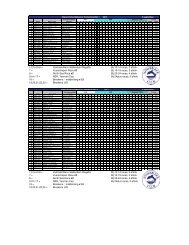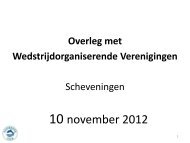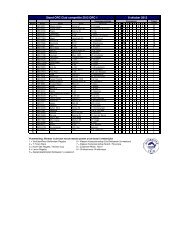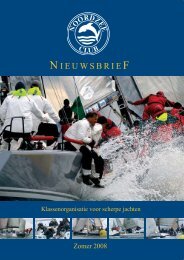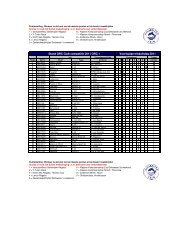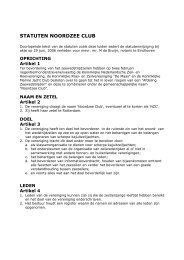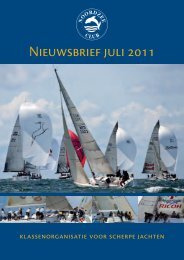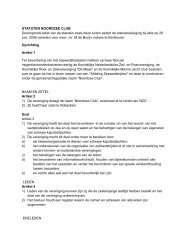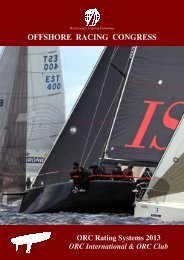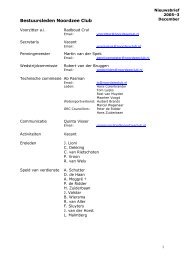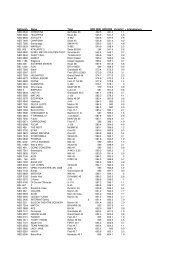HULL FACTOR; The IRC Thermometer! - Noordzee Club
HULL FACTOR; The IRC Thermometer! - Noordzee Club
HULL FACTOR; The IRC Thermometer! - Noordzee Club
You also want an ePaper? Increase the reach of your titles
YUMPU automatically turns print PDFs into web optimized ePapers that Google loves.
<strong>HULL</strong> <strong>FACTOR</strong>; <strong>The</strong> <strong>IRC</strong> <strong>The</strong>rmometer!<br />
<strong>IRC</strong> Hull Factor (HF) assessment is today to all intents and purposes wholly objective.<br />
<strong>The</strong> concept of HF first appeared in CHS, the Channel Handicap System, back in the 1980s. Initially,<br />
HF was wholly subjective. It was assessed by the two <strong>IRC</strong> rating offices using little more than intuition.<br />
With at that time CHS being largely an escape route from IOR for cruiser/racers and with only a small<br />
fleet centred largely in the UK and France, this worked perfectly satisfactorily. With the international<br />
growth of CHS through the 1990s, continued subjectivity plainly could not last.<br />
A significant part of the <strong>IRC</strong> Technical Committee’s work during this period was therefore aimed at<br />
developing ‘objective methods to answer a subjective question’. Thus, when at the end of the 1990s<br />
CHS became <strong>IRC</strong>, HF was already very largely objectively assessed. With continued work since then,<br />
HF assessment is today to all intents and purposes wholly objective.<br />
HF, perhaps because of its very nature, continues however to cause upset among owners and<br />
designers. <strong>The</strong> designers have a pretty good idea of what works under <strong>IRC</strong> in terms of the basic<br />
design parameters (length, weight, beam, draft, sail area, etc). But then along comes HF to upset all of<br />
that!<br />
Within the confidentiality constraints of a secret rule, plainly we cannot divulge the complete inner<br />
workings. We can however attempt to de-mystify and to explain the concepts.<br />
What is HF trying to achieve It is addressing the otherwise unrated elements of a boat. It is making a<br />
judgement of the likely ‘efficiency’ of the boat on a scale between pure cruiser and pure racer. A<br />
thermometer perhaps!<br />
<strong>IRC</strong> philosophy is to permit cruisers to race against cruiser/racers against racers with all boats having<br />
a chance of success. This then of course does not prohibit the design, construction and racing of oneoff<br />
‘<strong>IRC</strong> designs’. It does mean that <strong>IRC</strong> must at the very least attempt to recognise these designs for<br />
what they are. And that is where HF comes in with the aim not of ‘killing’ the boat, but rather of<br />
identifying and quantifying that under the apparent finery of a cruiser hides a racer.<br />
How then does this happen <strong>The</strong> starting point is the information contained on the <strong>IRC</strong> application<br />
form: Hull form, Keel Type and shape, Rudder, Hull material, Accommodation and Accommodation<br />
Materials, Other Appendage configuration. Expanding a little on these:<br />
We do not have the hull lines. We do know the general hull form, whether it is fair form, IOR inspired,<br />
clinker etc.<br />
We know quite a lot about the keel, particularly with in 2008 the publication of 13 generic keel types.<br />
We know whether it is just a fin or whether it is some form of low CG keel, whether or not it is a lifting<br />
keel, etc, etc.<br />
We know how many rudders the boat has and whether these are transom mounted, hung on a skeg or<br />
are spade configuration.<br />
We know what the boat is built from. Concrete through steel, aluminium, glassfibre, to the most exotic<br />
and up to date carbon and nomex.<br />
HF Le <strong>The</strong>romometre de l’<strong>IRC</strong> Final MJU 080206 1 Mike Urwin & Jean Sans. February 2008
We know how it is fitted out. Is it a completely stripped out dayboat or grand prix inshore racer Or is it<br />
a fully fitted world girdling cruiser with running hot and cold everything. Or, as nearly always,<br />
something in between. And what materials have been used in the construction of the interior<br />
We also know whether or not it has a novel appendage configuration. A canting keel or twin lifting<br />
daggerboards perhaps.<br />
And through the boat’s displacement/length ratio we have some idea of parametrically how heavy it is.<br />
And finally, we have any other information provided by the designer/builder/owner which may<br />
influence any of the above. <strong>The</strong> inclusion of some completely novel feature for instance.<br />
And how is this applied<br />
We know that every aspect of a boat will have some affect on its speed. Weight carried as fitout is less<br />
‘efficient’ in weight terms than the same weight as lead in the keel bulb. Concrete construction will<br />
result in a higher proportion of all up weight in the structure than steel than aluminium than glassfibre<br />
than carbon/nomex. A full fitout results in more weight distributed through the boat; higher pitching<br />
moment and in all probability a higher vertical centre of gravity. Etc etc. We can then assign a<br />
numerical value to each element using objective rules and methodologies developed over the years.<br />
Combining these then gives us HF<br />
That addresses new boats. When an existing boat is modified, a new keel or rudder perhaps, or<br />
changes to fitout (which must of course be declared), the same process is used.<br />
So, unlike the early days of CHS, HF assessment under <strong>IRC</strong> is as objective as it is realistically<br />
possible to be. Yes, of course there are subjective elements that we can never entirely escape. Is an<br />
extra berth worth as much as a microwave oven, a watermaker or a flat screen TV But that is avoided<br />
by taking a global view of fitout rather than applying the principles of the contents of a trolley at the<br />
supermarket checkout! And anyway, the differences in the final assessed value of HF would be small,<br />
and even smaller in terms of TCC.<br />
And putting the whole thing into context, ultimately within the sensible range for a particular concept of<br />
boat, the effect of HF on TCC is small, generally less than 0.005. Certainly smaller than the apparent<br />
importance ascribed to it by many owners and designers. In reality, the effect is far less than the gains<br />
to be made from hull preparation, rig tune, sails, navigation, tactics, etc……<br />
Jean SANS and Mike Urwin<br />
February 2008<br />
HF Le <strong>The</strong>romometre de l’<strong>IRC</strong> Final MJU 080206 2 Mike Urwin & Jean Sans. February 2008



